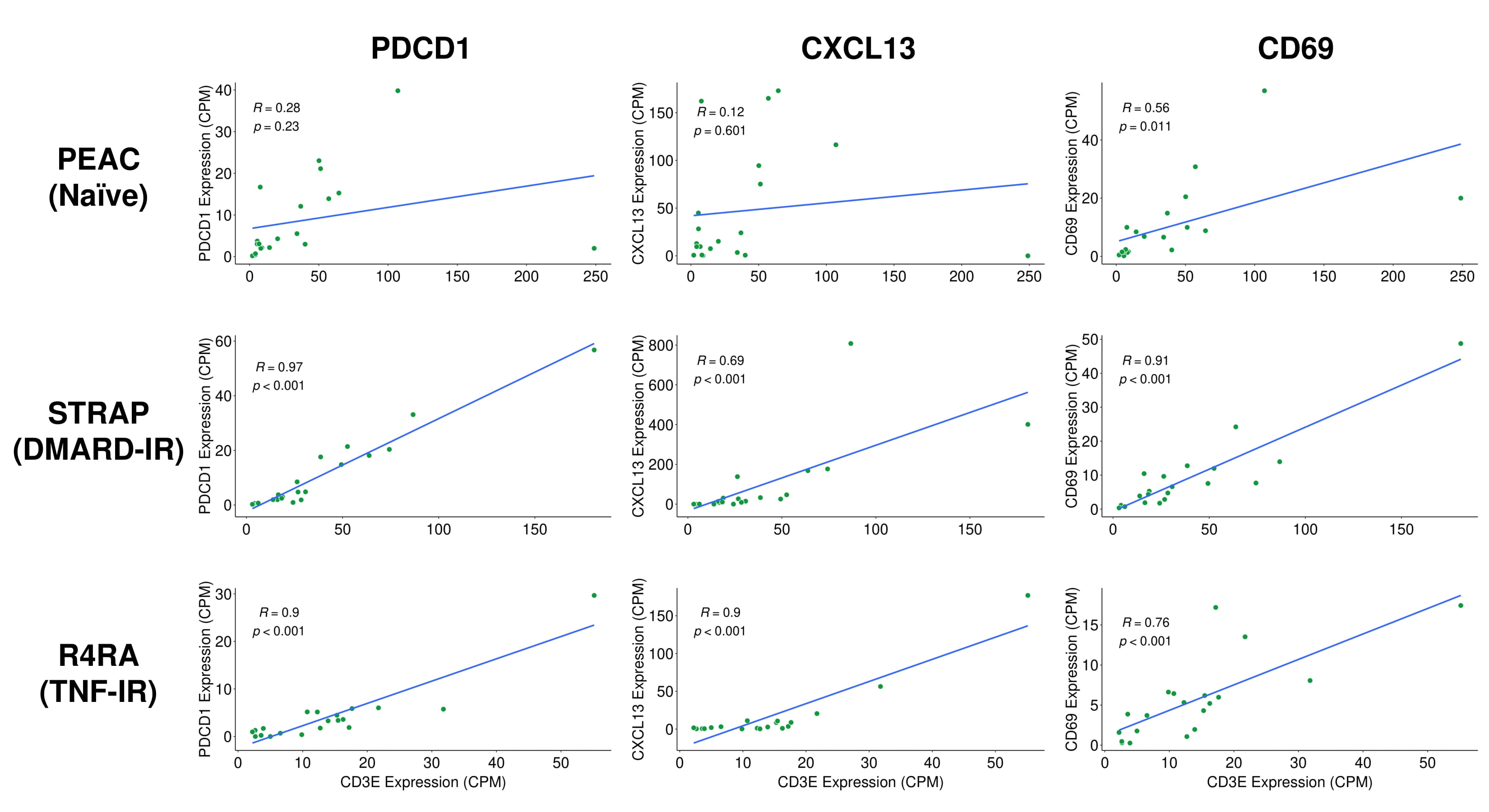Session Information
Date: Sunday, November 17, 2024
Title: RA – Treatment Poster II
Session Type: Poster Session B
Session Time: 10:30AM-12:30PM
Background/Purpose: Despite multiple approved therapies in rheumatoid arthritis (RA), many patients do not achieve clinically meaningful responses, emphasizing the need for novel therapeutics with improved efficacy. Rosnilimab is an IgG1 monoclonal antibody that reduces T cell activation through depletion of PD-1 high T cells and agonism of the PD-1 inhibitory receptor. In RA synovium, approximately 80% of T cells are PD-1 positive with an enrichment of CXCL13 secreting PD-1 high T peripheral helper (Tph) cells, which drive B cell differentiation to autoantibody producing plasma cells. To define potential target populations to rosnilimab therapy, we explored synovial PD-1-associated genes and pathways in three RA cohorts synchronized for disease stage and prior treatment exposure: (1) treatment-naive early RA (PEAC); (2) csDMARD-inadequate responders (IRs) (STRAP) and anti-TNF-IRs (R4RA).
Methods: Transcript expression levels were quantified and normalized using edgeR in synovial tissue bulk RNA-seq from the above cohorts. Pearson’s correlation was used to test associations between gene expression and clinical and imaging features. PD-1 associated pathways were analyzed using Gene Set Variation Analysis (GSVA) on two gene sets: a nivolumab-induced gene set (Choueiri et al 2016), and a rosnilimab-induced gene set generated using RNA-seq data from purified T cells co-cultured with monocyte-derived DCs and rosnilimab.
Results: In treatment naïve patients, synovial PD-1 transcript levels were positively correlated with clinical features at baseline. This included RF levels, anti-CCP titers, acute phase reactants (CRP p=0.01 and ESR p< 0.001), disease activity scores (DAS28-CRP p< 0.01 and DAS28-ESR p< 0.01), ultrasound synovial thickness (p< 0.001), and total Sharp van der Heijde radiographic scores (p< 0.001), with positive correlations also observed for CXCL13 transcript levels. Similar trends were observed in DMARD-IR and TNF-IR cohorts, particularly in relation to disease activity scores. When compared to the treatment naïve cohort, PD-1 transcript levels were also expressed in DMARD-IR and TNF-IR cohorts. Despite strong expression of synovial PD-1, anti-nivolumab (PD-1 antagonist) and rosnilimab (PD-1 agonist) gene signatures were not elevated suggesting that insufficient agonism may be contributing to active disease. T cell activation markers and CXCL13 expression levels closely correlated with CD3 expression across disease stages, indicating synovial T cells continue to exhibit an activated, Tph-like phenotype (Figure 1).
Conclusion: Synovial PD-1 and CXCL13 expression levels correlate with clinical markers of disease and persist across naïve, DMARD-IR, and TNF-IR patients with RA. This supports an important role for PD-1 in disease pathogenesis and the biologic rationale for using rosnilimab following different lines of therapy. This will be tested in the RENOIR study, an ongoing Phase 2 trial of rosnilimab in moderate/severe RA including biologic naïve and experienced patients (NCT06041269).
To cite this abstract in AMA style:
Ren Y, Aversa C, Lewis M, Cubuk C, Rivellese F, Fossati-Jimack L, Soroosh P, Archer A, Dahl M, Lizzul P, Sibley C, Pitzalis C. Synovial Expression Levels of PD-1, the Target of Rosnilimab, Correlate with Disease Activity and Persist Across Disease Stages and Lines of Therapy in Rheumatoid Arthritis [abstract]. Arthritis Rheumatol. 2024; 76 (suppl 9). https://acrabstracts.org/abstract/synovial-expression-levels-of-pd-1-the-target-of-rosnilimab-correlate-with-disease-activity-and-persist-across-disease-stages-and-lines-of-therapy-in-rheumatoid-arthritis/. Accessed .« Back to ACR Convergence 2024
ACR Meeting Abstracts - https://acrabstracts.org/abstract/synovial-expression-levels-of-pd-1-the-target-of-rosnilimab-correlate-with-disease-activity-and-persist-across-disease-stages-and-lines-of-therapy-in-rheumatoid-arthritis/

